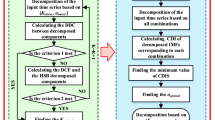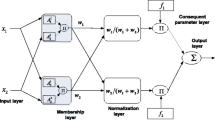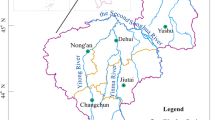Abstract
Landslide prediction is always the emphasis of landslide research. Using global positioning system GPS technologies to monitor the superficial displacements of landslide is a very useful and direct method in landslide evolution analysis. In this paper, an EEMD–ELM model [ensemble empirical mode decomposition (EEMD) based extreme learning machine (ELM) ensemble learning paradigm] is proposed to analysis the monitoring data for landslide displacement prediction. The rainfall data and reservoir level fluctuation data are also integrated into the study. The rainfall series, reservoir level fluctuation series and landslide accumulative displacement series are all decomposed into the residual series and a limited number of intrinsic mode functions with different frequencies from high to low using EEMD technique. A novel neural network technique, ELM, is employed to study the interactions of these sub-series at different frequency affecting landslide occurrence. Each sub-series extracted from accumulative displacement of landslide is forecasted respectively by establishing appropriate ELM model. The final prediction result is obtained by summing up the calculated predictive displacement value of each sub. The EEMD–ELM model shows the best accuracy comparing with basic artificial neural network models through forecasting the displacement of Baishuihe landslide in the Three Gorges reservoir area of China.
















Similar content being viewed by others
References
Battiti R (1994) Using mutual information for selecting features in supervised neural net learning. IEEE Trans Neural Netw 5(4):537–550
Chen HQ, Zeng ZG (2013) Deformation prediction of landslide based on improved back-propagation neural network. Cogn Comput 5(1):56–62
Drucker H, Cun YL (1992) Improving generalization performance using double backpropagation. IEEE Trans Neural Netw 3(6):991–997
Du J, Yin KL, Lacasse S (2013) Displacement prediction in colluvial landslides, three Gorges Reservoir. China Landslides 10(2):203–218
Frenzel S, Pompe B (2007) Partial mutual information for coupling analysis of multivariate time series. Phys Rev Lett 99(204101):1–4
Guo ZH, Zhao WG, Lu HY, Wang JZ (2012) Multi-step forecasting for wind speed using a modified EMD-based artificial neural network model. Renew Energy 37:241–249
Guzzetti F, Reichenbach P, Cardinali M, Galli M, Ardizzone F (2005) Probabilistic landslide hazard assessment at the basin scale. Geomorphology 72:272–299
Huang GB (2003) Learning capability and storage capacity of two-hidden-layer feedforward networks. IEEE Trans Neural Netw 14(2):274–281
Huang GB, Babri HA (1998) Upper bounds on the number of hidden neurons in feedforward networks with arbitrary bounded nonlinear activation functions. IEEE Trans Neural Netw 9(1):224–229
Huang GB, Chen L, Siew CK (2006) Universal approximation using incremental constructive feedforward networks with random hidden nodes. IEEE Trans Neural Netw 17(4):879–892
Huang GB, Zhu QY, Siew CK (2006) Extreme learning machine: theory and applications. Neurocomputing 70(1–3):489–501
Huang NE, Shen Z, Long SR, Wu MC, Shih HH, Zheng Q, Yen NC, Tung CC, Liu HH (1998) The empirical mode decomposition and the Hilbert spectrum for nonlinear and nonstationary time series analysis. Proc R Soc A 454:903–995
Jaroudi AE, Makhoul J (1990) A new error criterion for posterior probability estimation with neural nets. In: Proceedings of iteration joint conference on neural networks, pp. 185–192.
Kawabata D, Bandibas J (2009) Landslide susceptibility mapping using geological data, a DEM from ASTER images and an artificial neural network (ANN). Geomorphology 113:97–109
Kraskov A, Stogbauer H, Grassberger P (2004) Estimating mutual information. Phys Rev E 69(066138):1–16
Kwiatkowski D, Phillips PCB, Schmidt P, Shin Y (1992) Testing the null hypothesis of stationarity against the alternative of a unit root: how sure are we that economic time series have a unit root? J Econ 54(1–3):159–178
Liu ZG, Sun WL, Zeng JJ (2014) A new short-term load forecasting method of power system based on EEMD and SS-PSO. Neural Comput Appl 24(3–4):973–983
Melchiorre C, Matteucci M, Azzoni A, Zanchi A (2008) Artificial neural networks and cluster analysis in landslide susceptibility zonation. Geomorphology 94:379–400
Nefeslioglu HA, Gokceoglu C, Sonmez H (2008) An assessment on the use of logistic regression and artificial neural networks with different sampling strategies for the preparation of landslide susceptibility maps. Eng Geol 97:171–191
Paleologos EK, Skitzi I, Katsifarakis K, Darivianakis N (2013) Neural network simulation of spring flow in karst environments. Stoch Environ Res Risk Assess 27(8):1829–1837
Peyret M, Djamour Y, Rizza M, Ritz JF, Hurtrez JE, Goudarzi MA, Nankali H, Chery J, Le Dortz K, Uri F (2008) Monitoring of the largeslow Kahrodlandslide in Alborz mountainrange (Iran) by GPS and SAR interferometry. Eng Geol 100:131–141
Pozdnoukhov A, Kanevski M (2008) Multi-scale support vector algorithms for hot spot detection and modelling. Stoch Environ Res Risk Assess 22:647–660
Pradhan B, Lee S (2009) Landslide risk analysis using artificial neural network model focussing on different training sites. Int J Phys Sci 4(1):1–15
Pradhan B, Lee S, Buchroithner MF (2010) A GIS-based back-propagation neural network model and its cross-application and validation for landslide susceptibility analyses. Comput Environ Urb Syst 34:216–235
Qin SQ, Jiao JJ, Wang SJ (2001) The predictable time scale of landslides. Bull Eng Geol Environ 59(4):307–312
Qin SQ, Jiao JJ, Wang SJ (2002) A nonlinear dynamical model of landslide evolution. Geomorphology 43:77–85
Sharma A (2000) Seasonal to interannual rainfall probabilistic forecasts for improved water supply management. Part 1: A strategy for system predictor identification. J Hydrol 239(1–4):232–239
Singh P, Borah B (2013) Indian summer monsoon rainfall prediction using artificial neural network. Stoch Environ Res Risk Assess 27:1585–1599
Sorbino G, Sica C, Cascini L (2010) Susceptibility analysis of shallow landslides source areas using physically based models. Nat Hazards 53:313–332
Tagliavini F, Mantovani M, Marcato G, Pasuto A, Silvano S (2007) Validation of landslide hazard assessment by means of GPS monitoring techniquea case study in the Dolomites (Eastern Alps, Italy). Nat Hazards Earth Syst Sci 7:185–193
Tamura S, Tateishi M (1997) Capabilities of a four-layered feedforward neural network: four layers versus three. IEEE Trans Neural Netw 8:251–255
Tourassi GD, Frederick ED, Markey MK, Floyd CEJ (2001) Application of the mutual information criterion for feature selection in computer-aided diagnosis. Med Phys 28(12):2394–2402
Wang G, Philips D, Joyce J, Rivera FO (2011) The integration of TLS and continuous GPS to study landslide deformation: a case study in Puerto Rico. J Geod Sci 1:25–34
Wang GQ (2012) Kinematics of the Cerca del Cielo, Puerto Rico landslide derived from GPS observations. Landslides 9:117–130
Wu ZH, Huang NE (2009) Ensemble empirical mode decomposition: a noise-assisted data analysis method. Adv Adapt Data Anal 1:1–41
Zhu QY, Qin AK, Suganthan PN, Huang GB (2005) Evolutionary extreme learning machine. Pattern Recognit 38:1759–1763
Acknowledgments
The work is supported by the Natural Science Foundation of China under Grant 61125303 and 61203286, National Basic Research Program of China (973 Program) under Grant 2011CB710606, the Program for Science and Technology in Wuhan of China under Grant 2014010101010004, the Program for Changjiang Scholars and Innovative Research Team in University of China under Grant IRT1245.
Author information
Authors and Affiliations
Corresponding author
Rights and permissions
About this article
Cite this article
Lian, C., Zeng, Z., Yao, W. et al. Extreme learning machine for the displacement prediction of landslide under rainfall and reservoir level. Stoch Environ Res Risk Assess 28, 1957–1972 (2014). https://doi.org/10.1007/s00477-014-0875-6
Received:
Accepted:
Published:
Issue Date:
DOI: https://doi.org/10.1007/s00477-014-0875-6




